For 21st century India’s 350 million increasingly stress-prone citizens scrambling to earn a living in the country’s estimated 7,900 towns and cities defined by 19th century housing, haphazard town planning, persistent power outages, reckless automotive traffic and open, uninterrupted and continuous municipal corruption, here’s some good news
.gif) An ambitious, never-before enterprise of great pith and moment — the Indian Institute for Human Settlements (IIHS) — has quietly commenced operations in the institute’s two offices in Kasturba Gandhi Marg, New Delhi and Rajmahal Vilas Extension, a leafy suburb of Bangalore across the road from the Indian Institute of Science. In January this year a team of core faculty launched its initial one week, part-time Programme for Working Professionals (PWP) even as its high-potential Consultancy and Advisory Services division signed up its first knowledge partnership agreement with the Karnataka state government’s Bangalore Development Authority. But these are this novel institute’s supplem-entary initiatives.
An ambitious, never-before enterprise of great pith and moment — the Indian Institute for Human Settlements (IIHS) — has quietly commenced operations in the institute’s two offices in Kasturba Gandhi Marg, New Delhi and Rajmahal Vilas Extension, a leafy suburb of Bangalore across the road from the Indian Institute of Science. In January this year a team of core faculty launched its initial one week, part-time Programme for Working Professionals (PWP) even as its high-potential Consultancy and Advisory Services division signed up its first knowledge partnership agreement with the Karnataka state government’s Bangalore Development Authority. But these are this novel institute’s supplem-entary initiatives.
IIHS’ spearhead project is the country’s first-ever IIHS University, a comprehensively modern Rs.250 crore higher education institution for urban practice — the first of the 14 innovation universities announced by Union HRD minister Kapil Sibal in August 2009 — whose detailed blueprint is ready for implementation. This blueprint — several months in the making — details construction of a state-of-the-art university campus with an initial built-up area of 50,000 sq. metres including student and faculty housing and related social infrastructure on a 40 acre site in Kengeri, a suburb of Bangalore. “It will demonstrate the talent of India’s best designers, construction agencies and artisans and become a global hub for urban knowledge and innovation,” promises the IIHS website (www.iihs. co.in).
The idea of promoting this ambitious enterprise was born out of the collective desperation rather than philanthropic impulses, of several captains of industry and the construction and housing industries in particular who — like most educated middle class citizens — are in despair over the slapdash and haphazard growth of India’s cities and towns which are on course to house, support and provide employment to 590 million citizens by the year 2030. Currently (mis)managed by minimally — if at all — trained municipal clerks sporting impressive designations, 21st century India’s cities and townships are rapidly deteriorating into cesspools of dirt, disease and degradation, hurtling towards urban disaster in terms of traffic gridlock, and insanitary crime-ridden slums housing more than half their population.
With the nation’s political leaders who despite jetting abroad at public expense on the slightest pretext, remaining blind to the vast advances in civic management and town planning in developed OECD (Organisation for Economic Cooperation and Development) countries, in end 2008 a concerned group of 16 business, banking and industry leaders including HDFC chairman Deepak Parekh; Air Freight chairman Cyrus Guzder; Jamshyd Godrej; Keshub Mahindra; and UID chief Nandan Nilekani among others, promoted IIHS as a not-for-profit company under s.25 of the Indian Companies Act, 1956, contributing Rs.15 crore to the institute’s initial corpus.
Comments IIHS’ India Vision 2030 draft working paper: “The fundamental constraint to the orderly growth and transformation of urban India is neither capital nor perhaps technology. The chief impediment is the (un)availability of sufficient number of well-educated professionals committed to the common good who can play the role of change-makers and entrepreneurs. Unfortunately, India’s higher education system has no professional programme built around interdisciplinary skills or the scale needed to educate enough learners for the satisfactory planning, development and management of India’s cities, towns and villages.
“IIHS was incorporated to address this multi-dimensional and inter-disciplinary challenge so that the country can respond with wise and timely solutions. IIHS aims to establish India’s first independently funded and managed National Innovation University focused on the challenges and opportunities of urbanisation. The university is intended to be a globally ranked institution at par with the celebrated Indian Institutes of Technology (IITs) and Indian Institutes of Management (IIMs).”
The prospect of intelligently addressing and resolving the accelerating urban blight of India’s chaotic wealth generating metropolises (Mumbai, Delhi, Kolkata, Chennai and Bangalore) as also the country’s thousands of tier-II and tier-III towns and state capitals which, given the pathetic failure of Soviet-inspired central planning, has resulted in mass migration of rural refugees into urban India thus over-stretching its pre-independence era infrastructure, is obviously exciting. Last month (July), it prompted former Infosys Technologies promoter-CEO Nandan Nilekani and his wife Rohini to endow the institute with Rs.50 crore to promote a School of Environment & Sustainability.
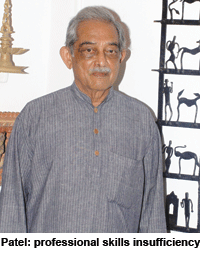 “Looking around the country, it’s plainly obvious that not only our cities, but smaller towns as well, are in a mess, and likely to get worse. Part of the problem is governance, where effective civic power is not as it should be, vested in locally elected leaders but is in the hands of state government leaders whose interest in towns and cities is limited. Besides, there is an insufficiency of professional skills to develop and implement strategies and projects needed to improve the urban condition. IIHS has been conceived as a response to this urgent need. We expect the institute and the university to develop a cadre of professionals dedicated to urban affairs — not just planning, but also (formulating) policy issues and involved with project implementation, urban management and governance,” says Shirish Patel, a civil engineer and architect who designed Mumbai’s first flyover, was one of the authors of the New Bombay (Navi Mumbai) project (1965) and a founder-promoter of IIHS.
“Looking around the country, it’s plainly obvious that not only our cities, but smaller towns as well, are in a mess, and likely to get worse. Part of the problem is governance, where effective civic power is not as it should be, vested in locally elected leaders but is in the hands of state government leaders whose interest in towns and cities is limited. Besides, there is an insufficiency of professional skills to develop and implement strategies and projects needed to improve the urban condition. IIHS has been conceived as a response to this urgent need. We expect the institute and the university to develop a cadre of professionals dedicated to urban affairs — not just planning, but also (formulating) policy issues and involved with project implementation, urban management and governance,” says Shirish Patel, a civil engineer and architect who designed Mumbai’s first flyover, was one of the authors of the New Bombay (Navi Mumbai) project (1965) and a founder-promoter of IIHS.
Although there is an unquestionably desperate need for a new multi-disciplinary university teaching and researching ways and means to plan and manage India’s exploding cities, it is pertinent to note that the proposed IIHS University won’t be the first urban habitats planning and management institution in the country. The well-reputed School for Planning and Architecture, Delhi (SPA, estb.1941), which was conferred deemed university status in 1979, claims to be a “specialised university, the only one of its kind, which exclusively provides training at various levels, in different aspects of human habitat and environment”, and has half a dozen clones across the country.
In addition, there’s the Ahmedabad-based Centre for Environment Planning and Technology University (CEPT, estb.1962) which includes a School of Building Science and Technology and School of Interior Design established in 1982 and 1991 respectively. Between them, over the past half century these essentially government-funded and managed urban planning and management universities have churned out thousands of town and urban planners. But quite evidently they have been unable to prevent the descent of India’s cities and towns into chaos and confusion for a variety of reasons (see box).
That’s perhaps why the top brass of IIHS takes considerable pains to distinguish the proposed IIHS University from predecessor institutions such as SPA and CEPT. “We are not an architecture, management or planning school, though all of these issues will be addressed. It’s a new profession that we are creating and we’re calling it urban practice. These are people who will work on the ground to make change... We are also trying to bring an understanding of law and governance, and centrally, the social sciences, politics and history. We have to address the questions of ‘why’ and not merely ‘how’, and this is important if they have to learn how to innovate. That’s why we have some of the best people in the world working with us to help answer these questions. So we have colleagues from the School of Planning and Architecture, MIT (Massachusetts Institute of Techno-logy); University College, London; Brazil and South Africa,” explained Aromar Revi, an alumnus of IIT-Delhi, founder-director of TARU, a highly reputed Delhi-based research and consulting firm and former advisor to the Planning Commission, World Bank, UNEP, UNU and DFID, who is currently the prom-oter-chief executive of IIHS, in an interview with the business daily Mint (July 1).
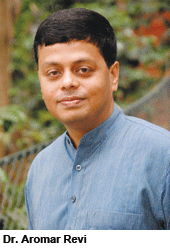 In a subsequent interview with EducationWorld as well, Revi took pains to stress that IIHS University has been conceptualised as an inter-disciplinary institution of higher education and research ab initio, unlike SPA and CEPT in which town planning, urban management and governance were offshoots of their schools of architecture. Moreover, perhaps fearful of the dead but highly interventionist hand of government in publicly funded academic institutions, Revi and the promoter group of IIHS are determined to ensure full financial autonomy for the proposed IIHS University (see interview).
In a subsequent interview with EducationWorld as well, Revi took pains to stress that IIHS University has been conceptualised as an inter-disciplinary institution of higher education and research ab initio, unlike SPA and CEPT in which town planning, urban management and governance were offshoots of their schools of architecture. Moreover, perhaps fearful of the dead but highly interventionist hand of government in publicly funded academic institutions, Revi and the promoter group of IIHS are determined to ensure full financial autonomy for the proposed IIHS University (see interview).
Quite obviously IIHS-type academic innovations — graduating urban practitioners with mixed architecture, civil engineering, project management, economics and law education — won’t be tolerated in a government-funded university over which rules and precedent-obsessed bureaucrats and compliant old world academics have a stranglehold. Therefore the promoters of IIHS — a not-for-profit company rather than the conventional charitable trust or society — have modeled the university on the lines of the Hyderabad-based Indian School of Business (ISB) which was established in 1999 with a privately subscribed capital outlay of over Rs.250 crore.
ISB is a good and successful model. Since this state-of-the-art privately-promoted B-school sprawled over a 260-acre campus in Gachibowli, was promoted in suburban Hyderabad 12 years ago, it has emerged as one of the world’s top business management institutes matching the best B-schools globally in terms of layout, academic facilities, residential accommodation and the quality of its postgraduates. Its 13-month intensive MBA programme is rated on a par with the 24-month MBA programmes of the IIMs of over 50 years vintage, with the London-based Financial Times ranking ISB among the top 20 B-schools worldwide.
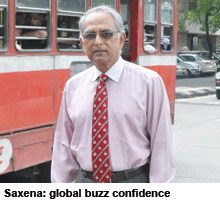 Consequently with some of the biggest names in Indian industry and finance backing IIHS and having already subscribed — even if modestly — to its endowment corpus fund, which following the surprise contribution of Rs.50 crore by the Nilekanis has already swelled to Rs.70 crore, the institute’s management anticipates at best minor problems in raising the Rs.400 crore required to construct and commission the proposed IIHS University in Bangalore on schedule. “The idea of setting up the world’s first interdiscip-linary university to train and graduate urban practice professionals has generated great enthusiasm and created a global buzz. The project has got off to a quick start, and thus far is moving ahead of schedule. Perhaps the only milestone remaining to be crossed is passage of the Innovation Universities Bill by Parliament in which there is a legislative logjam currently. I’m very confident of being able to mobilise the Rs.400 crore corpus required to build the campus and get the university rolling,” says Pradeep Saxena, the highly experienced (Grindlays, Amex, Merrill Lynch, ING Baring etc) Mumbai-based executive director of IIHS, spear-heading the institute’s global fund-raising drive.
Consequently with some of the biggest names in Indian industry and finance backing IIHS and having already subscribed — even if modestly — to its endowment corpus fund, which following the surprise contribution of Rs.50 crore by the Nilekanis has already swelled to Rs.70 crore, the institute’s management anticipates at best minor problems in raising the Rs.400 crore required to construct and commission the proposed IIHS University in Bangalore on schedule. “The idea of setting up the world’s first interdiscip-linary university to train and graduate urban practice professionals has generated great enthusiasm and created a global buzz. The project has got off to a quick start, and thus far is moving ahead of schedule. Perhaps the only milestone remaining to be crossed is passage of the Innovation Universities Bill by Parliament in which there is a legislative logjam currently. I’m very confident of being able to mobilise the Rs.400 crore corpus required to build the campus and get the university rolling,” says Pradeep Saxena, the highly experienced (Grindlays, Amex, Merrill Lynch, ING Baring etc) Mumbai-based executive director of IIHS, spear-heading the institute’s global fund-raising drive.
With its core team of highly successful professionals with impressive track records already up and running, it’s unsurprising that Project IIHS which offers a lifeline to India’s sinking cities, has got off to an urgent flying start. According to A. Suryanarayanan, a chartered accoun-tant and alumnus of McGill University and hitherto chief operating officer of the N.S. Raghavan Centre for Entrep-reneurial Learning of IIM-Bangalore who is currently head of operations at IIHS, the institute has already become operational with several PWP (progra-mme for working professionals) courses being conducted for Central and state government employees, NGOs and entrepreneurs.
“My brief is to get IIHS and IIHS University off the ground as fast as possible and thus far the project is running as per schedule with two of our three verticals operational. As soon as the Innovation Universities Bill is passed by Parliament we will admit the first batch into our two-year Master of urban practice programme. Meanwhile I am confident of completing the first phase of construction of our campus at Kengeri, Bangalore by April 2014 when we will admit the first batch of undergraduate students. Our objective is to quickly educate and graduate interdisciplinary urban development practitioners including social and for-profit entrepreneurs who will make India’s cities — indeed all of the country’s settlements — inhabitable and enjoyable for all citizens. It’s still not too late to save the situation,” says Suryanarayanan.
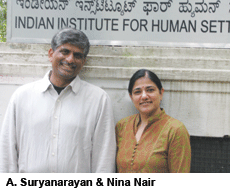 Given that contemporary India is ranked 134 (of 183 nations listed) on the World Bank’s Ease of Doing Business Index (2010), the promoters and can-do managers of IIHS have done well to get a project of such scale and magnitude up and running within 24 months. But this notable achievement is likely to pale in comparison with the magnitude of the task involved in finding faculty to develop and deliver the university’s unique curriculum.
Given that contemporary India is ranked 134 (of 183 nations listed) on the World Bank’s Ease of Doing Business Index (2010), the promoters and can-do managers of IIHS have done well to get a project of such scale and magnitude up and running within 24 months. But this notable achievement is likely to pale in comparison with the magnitude of the task involved in finding faculty to develop and deliver the university’s unique curriculum.
According to management project-ions, by the year 2017 when the university will be running full throttle, it will employ 309 administrators and managers and 105 highly-qualified faculty from around the world. Meanwhile the first batch of 100 students for the 24-month Master of urban practice programme will be admitted next year and the initial batch of 240 undergrads in 2014, when the first phase of construction at the Kengeri campus is completed.
“Selecting qualified faculty with the right mix of research, teaching and practice experience and capability to develop and mentor undergraduate, postgrad and doctoral students is the critical factor which will determine the success of IIHS University. To this end we have initiated a global search for faculty and have also signed academic and curriculum development agree-ments with some of the world’s top universities including the Massachusetts Institute of Technology’s School of Architecture & Planning, University College London’s Development Planning Unit for Europe and the University of Cape Town’s African Centre for Cities. Moreover the curriculum development effort is also being complemented by global corporate leaders Arup and Ideo engaged in design, planning and management of urban habitats around the world. Currently 160 leading academics, practitioners, public, business and civil society leaders in India and worldwide are engaged in developing the interdisciplinary curriculum of IIHS University,” says Nina Nair, an economics and education graduate of Madras and Annamalai universities with 16 years of teaching experience in schools, and former vice president (HRD) of 24/7 Customer Pvt. Ltd who is currently the Bangalore-based ‘chief people officer’ of IIHS.
This globally unprecedented initiative which promises to create a new profession of urban practitioners on a sustained basis to save the country’s rapidly sinking metros and disorderly towns and settlements, has aroused considerable interest and enthusiasm within the beleaguered communities of architects, builders and civic planners who are being increasingly being targeted for the chaotic conditions prevalent in the country’s estimated 7,900 urban habitats which currently house 350 million and will multiply in number and size to house 590 million by the year 2030.
“The proposed IIHS University is a welcome initiative. Currently the problem in town and civic planning is that the top planner is usually an IAS generalist subject to the pulls and pressures of a host of specialists — architects, civil engineers, structural engineers, builders, road planners etc — which makes it impossible to draw up balanced and well-integrated master plans. Therefore urban development plans tend to be flawed right from the start. The prospect of the proposed IIHS University producing urban practitioners with interdisciplinary education which will enable them to see the bigger picture and network with specialists to plan and design urban habitats and townships is a much-needed and promising development,” says Dinesh Verma, an alumnus of Regional Engineering College, Nagpur and IIT-Bombay and currently managing director of the Bangalore-based ACE Group Pvt. Ltd, a fast track architectural and civil engineering firm. Among the institutions which Verma has designed and commiss-ioned: the Indus International School, Bangalore; Dhruva Academy, Sangh-amner (Maharashtra) and the new VIT University campus in Bangalore.
However Charles Correia, the well-known Mumbai-based architect and town planner who was the chief architect of Navi Mumbai, has engineered the construction of several townships in Mumbai, Delhi, Ahmedabad and Bangalore, and is currently the Farwell Bemis professor in the School of Architecture and Planning at MIT (USA), expresses reservations about the IIHS University development model.
“Attracting top-rung faculty into a greenfield university is likely to prove a major problem for IIHS. It might have been less of a problem if instead of a new university, the promoters had established a Centre of Human Settlements within a well-reputed university as MIT, Boston has done. This is also the institutional model eminent astronomer and scientist Jayant Narlikar has followed by establishing the Inter-University Centre for Astronomy and Astrophysics, Pune under the aegis of the Tata Institute of Fundamental Research. Persuading the best academic talent to work in schools and faculties of a greenfield university is likely to prove a formidable challenge,” says Correia.
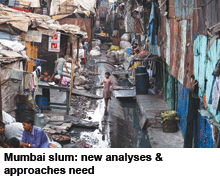 While gestating IIHS and the in-process IIHS University, the promoters and management think-tank had undoubtedly weighed the pros and cons of planting the seeds of a greenfield IIHS University and/or grafting it onto a reputed established university. Although the graft option offers the benefit of a smoother take off, it requires management of the institutional culture and traditions of the parent university. Moreover the new centre as proposed by Correia would be just another school of the parent university, rather than the hub and fulcrum of an entirely new body of learning with its own schools of numerous urban and rural settlement development sciences.
While gestating IIHS and the in-process IIHS University, the promoters and management think-tank had undoubtedly weighed the pros and cons of planting the seeds of a greenfield IIHS University and/or grafting it onto a reputed established university. Although the graft option offers the benefit of a smoother take off, it requires management of the institutional culture and traditions of the parent university. Moreover the new centre as proposed by Correia would be just another school of the parent university, rather than the hub and fulcrum of an entirely new body of learning with its own schools of numerous urban and rural settlement development sciences.
“In IIHS, we are well aware that great universities are built and established over centuries. India’s great universities such as IISc and Santiniketan were built in the first wave of nation-building when India began its long journey of transfor-mation from an agrarian towards an industrial economy. IIHS University has been conceptualised and is being constructed in the second wave of nation-building when industry and the services sector contribute more than two-thirds of India’s annual GDP. Despite this, even in the year 2050, half our population will reside in rural India. Therefore the ‘human settlements’ challenges confronting India in 2050 will require completely new analyses and approaches, with a new system of interdisciplinary and integrated civic development and management educa-tion. The mission and objective of IIHS University is to stimulate academic innovation supplemented by practice to save our settlements and cities in particular, within the nation’s democratic framework,” says Aromar Revi, director of IIHS.
With awareness that the population of 21st century India’s ramshackle cities characterised by slapdash planning, power outages, chaotic vehicular traffic and spreading slums will rise from the current 350 million to 590 million by 2030, the proposed university which promises to develop a new genre of urban practitioners equipped with inter-disciplinary skills spanning architecture, town planning, law, economics, demogr-aphics, transport, logistics among other disciplines is receiving top-level support. A sign of this awakening is the Centre’s newly introduced (2005) Rs.50,000 crore Jawaharlal Nehru Urban Renewal Mission (JNURM) to upgrade the crumbling infrastructure of the country 63 major cities.
Suddenly there’s blinding awareness within the establishment and intelligen-tsia even if not beyond, that if India’s neglected cities which generate two-thirds of the nation’s wealth collapse into chaos and confusion, middle class India’s mirage of India shining will become a nightmare. Hence the critical importance of the IIHS University which deserves the moral and material support of all right-thinking members of society with a vested interest in the transfor-mation of our ugly, unequal nation into a peaceful and prosperous society.